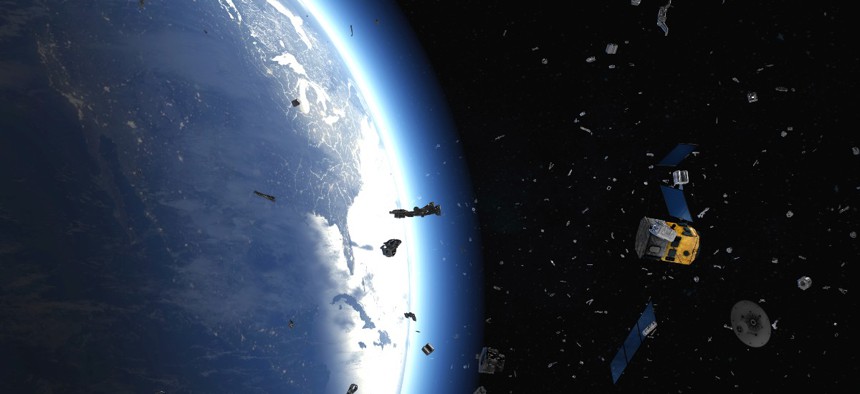FCC Adopts New 5-Year Rule for Orbital Debris, Despite Pushback

CHRISTOPH BURGSTEDT/SCIENCE PHOTO LIBRARY/Getty Images
Earlier this week, lawmakers raised concerns about the FCC’s proposal.
Despite pushback over its impacts on consistency across agencies, the Federal Communications Commission has unanimously approved and adopted a new rule seeking to minimize orbital debris at its monthly meeting held on Thursday.
Orbital debris “consists of human-made objects orbiting Earth that no longer serve a purpose, including mission-related and fragmentation debris, nonfunctional spacecraft and abandoned rocket stages,” according to NASA.
The FCC proposed replacing longstanding guidelines earlier this month. The agency’s newly adopted rule would require satellites that end their mission in or pass through the low-Earth orbit region—defined by NASA as anything with an altitude of 1,200 miles or 2,000 kilometers and below—to deorbit as soon as possible but within five years, instead of the previous 25-year timeframe.
The FCC voted 4-0 in favor of the rule, which will apply to satellites—both U.S.-licensed satellites and those licensed in other jurisdictions but seeking access to the U.S. market—launched two years after the order is adopted.
The agency stated that this change is “taking an important step in a new era for space safety and orbital debris policy.” Moreover, the agency added, “the new 5-year rule for deorbiting satellites will mean more accountability and less risk of costly collisions that increase debris.”
There were more than 4,800 satellites operating in orbit as of the end of 2021, of which most are commercial low-Earth orbit satellites. According to the FCC, there is a growing amount of orbital debris that creates challenges for space missions and can cause collisions.
“For years, it has been the recommended practice for satellite operators to deorbit their spacecraft within 25 years of completing their missions,” FCC Chairwoman Jessica Rosenworcel said. “But 25 years is a long time. There is no reason to wait that long anymore, especially in low-Earth orbit. Our space economy is moving fast. The second space age is here. For it to continue to grow, we need to do more to clean up after ourselves, so space innovation can continue to respond.”
“If thousands of new satellites launch every year and are replenished every 5, 10 or 15 years, yet take 25 years to demise once the mission is done, the rate of debris accumulation will grow rapidly, and perhaps unsustainably,” FCC Commissioner Geoffrey Starks said. “More objects remaining in crowded orbits for longer will potentially generate more collisions. Each one of those collisions would generate massive quantities of debris, continuing the cycle.”
However, on Tuesday, lawmakers expressed concerns that the FCC was acting alone in addition to questioning its authority to promulgate this rule. There was also concern that this change would cause confusion, due to the lack of coordination with other agencies. The lawmakers asked the FCC to delay their consideration of this proposed rule.
The FCC has been working on this new rulemaking for several years, and it previously updated the rulemaking in 2020.
In regards to the FCC’s adoption of this new rule, a NASA spokesperson told Nextgov, “NASA commented on the referenced FCC rulemaking in 2019 and 2020. We do not have more to add beyond those comments at this time.”
In its comments, NASA stated that the agency’s Science Mission Directorate “agrees with the existence of a limit on post-mission orbital lifetime, even with the adoption of a maneuverability requirement. Creation of policy is highly desirable to prevent potential abuse, which could exist if operations are not required to remove defunct satellites from high value orbits for unreasonably long periods of time.”
For example, NASA SMD is concerned that “if applied to all mission applications, decreasing the limit would impact the science achievable, limit the orbits available for scientific observation, and make waivers a common occurrence. Specific to science missions, a limit of 5-years would significantly impact all of NASA SMD’s CubeSat missions which rely on natural decay of orbits to manage post mission orbital lifetime and require nearly all missions to request a waiver, which would become costly and an added bureaucratic burden.”
NEXT STORY: Panel votes up House modernization plan






